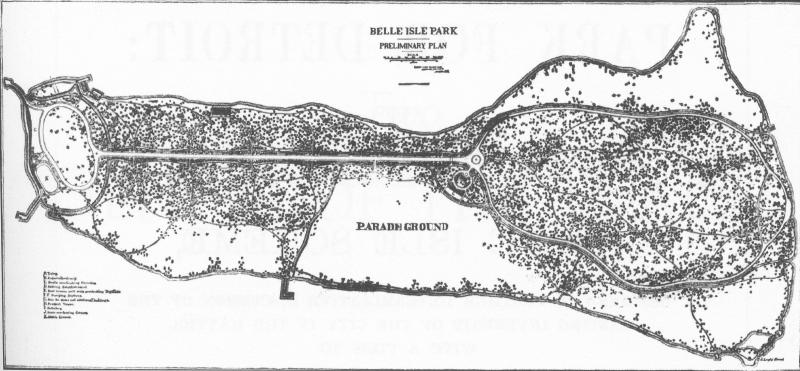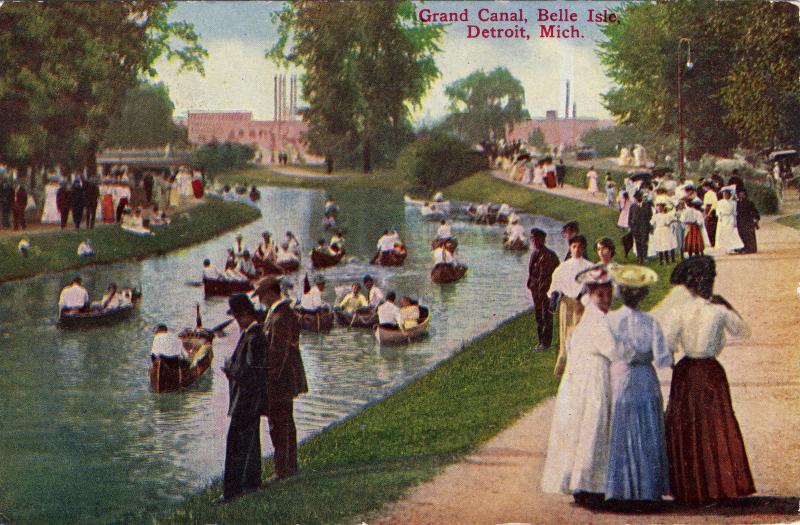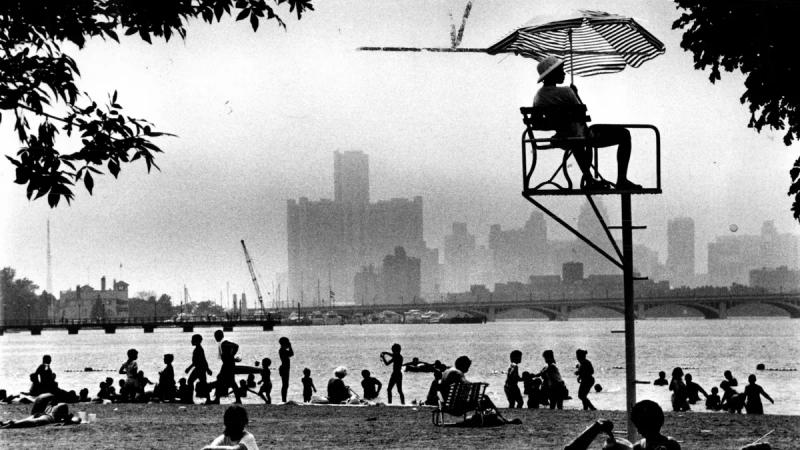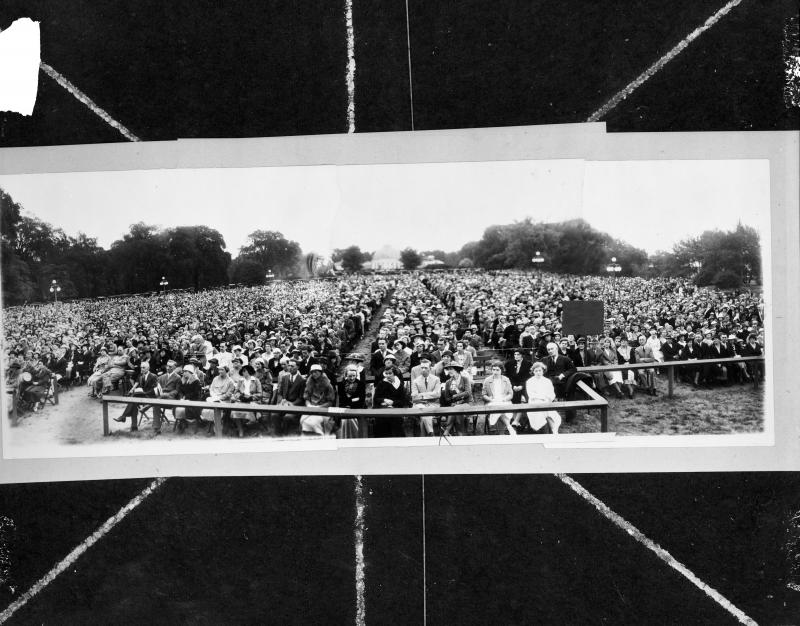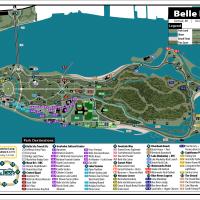-
Name of property current (historical)
-
Belle Isle Park
-
Entry author
-
Rachel Liu
-
Abstract
-
Belle Isle Park is a 982-acre island park located in the Detroit River in Detroit, Michigan. Designed by Frederick Law Olmsted and Charles Eliot, the park has served as an important cultural and recreational destination for Detroiters for over a century. Belle Isle Park opened for all seasons in 1889, and in the following year, several cultural institutions were added to the park.
The park reflects the goals and aspirations of the City Beautiful Movement, a progressive urban planning movement that emerged in the United State in the late 19th and 20th centuries. The movement sought to create a more beautiful and harmonious urban environment.
-
Address
-
99 Pleasure Dr
Detroit, Michigan 48207
-
Architect
-
Frederick Law Olmsted- Landscape Architect
Charles Eliot - Landscape Architect
-
Date (comission)
-
1881- The City of Detroit hired Frederick Law Olmsted to design Belle Isle Park.
-
Date (completion)
-
1889- Belle Isle was opened as a park for all seasons.
-
Program/ function
-
Recreation
-
Contractor
-
The Michigan Department of Natural Resources manages Belle Isle under the Belle Isle Park Advisory Committee. The Committee advises the state on the implementation of improvements, master planning, and public safety in Belle Isle Park.
-
Date (modification, adaptation, renovation)
-
1904- Anna Scripps Whitcomb Conservatory was built.
1904- Belle Isle Aquarium was built.
1908- Belle Isle Casino was built.
1921- Alpheus Starkey Williams Statue was built.
1925- James Scott Memorial Fountain was built.
1930- William Livingstone Memorial Lighthouse was built.
1932- Reverend Samuel Francis Smith Flagpole was built.
1940- Nancy Brown Peace Carillon was built.
1961- Dossin Great Lakes Museum was built.
1991- Atom Gazelle Sculpture was built.
-
Gift giver/ funder/ contributor
-
1879- The City of Detroit purchased Belle Isle from Barnabas Campeau’s descendants.
-
Beneficiaries and impact on the community
-
The park has also hosted many cultural and community events over the years, including concerts, festivals, and public gatherings.
The park attracts thousands of visitors each year, generating revenue for local businesses and supporting jobs in the hospitality and tourism sectors.
-
Was it part of a network of buildings?
-
Belle Isle Park is part of a network of buildings. The park contains a number of important cultural institutions, such as the Belle Isle Conservatory, the Belle Isle Aquarium, and the Anna Scripps Whitcomb Conservatory.
-
Sustainability (financial, cultural)
-
On November 12, 2013, the Local Emergency Financial Assistance Loan Board voted to accept a 30-year lease with up to two 15-year extensions of Belle Isle from the City of Detroit to the State of Michigan. The lease will turn over to the Department of Natural Resources (DNR) responsibility for the maintenance of and capital improvements to Belle Isle; the DNR will manage the island as a State park. A source for ongoing funding for the park has not yet been identified; however, the fiscal year (FY) 2013-14 DNR budget contains a $2.5 million General Fund/General Purpose appropriation for Belle Isle operational costs. This article will provide a summary of the lease agreement, a discussion of the fiscal impacts of the lease on the State and the City, and some options for ongoing funding for the park. (“State Notes - Winter 2014 - Michigan Senate.”)
-
Size/ scale
-
2.5-mile-long, 982-acre
-
Was the community involved in the process?
-
When the state of Michigan took over the management of the park in 2014, they formed a Belle Isle Advisory Committee made up of community members and stakeholders to provide input on the park's management and development (Lewis, Shawn D). The committee meets regularly to discuss park issues and provide feedback to the state.
The state has also partnered with community organizations to host events and activities in the park, such as the annual Belle Isle Art Fair and the Detroit Grand Prix, which draws visitors from across the region.
-
Q1: What were the motivations of the gift-giver and the implications of the gift for the community ?
-
During the late 19th century, Detroit faced an issue of immigration, unemployment, and population growth. In reaction to both environmental and demographic concerns, the city is eager to transform itself into a place with the order and prestige of a great metropolis. City and civic leaders, planners, and ordinary residents were increasingly recognizing the value and significance of the environment in which they lived. As they discussed ways to reshape and repurpose the city's landscape, the City of Detroit uses public work projects to implement the ideas about how human beings could interact with nature within an industrial context (Joseph Stanhope Cialdella). Belle Isle Park was one of the largest and most ambitious public project, and it was designed to serve as a centerpiece of the city's park system during the time.
In terms of labor, the construction and maintenance of Belle Isle provided jobs for local workers. The park also created opportunities for entrepreneurs, such as food vendors and concessionaires, who could set up businesses within the park. In terms of the program, Belle Isle offered a wide range of recreational activities, including boating, fishing, picnicking, and sports. The park also featured cultural and educational programming, such as concretes, lectures, and exhibits.
-
Q2: Was there an imposed sense of responsibility or reciprocation in the case study, and who were the parties that were charged with these actions?
-
The construction of the park was seen as a way to enhance the reputation of the city of Detroit and its elite citizens, who were seen as patrons of art and culture. Additionally, the giver hoped to benefit financially from the increased property value and economic activity that would result from the creation of the park.
The responsibility for maintaining and improving Belle Isle largely fell to the City of Detroit and its parks and recreation department. The park has attracted many private investments and philanthropy to fund the improvement of the park, such as The Belle Isle Conservancy, which was founded in 2014 to support the park's preservation and development (Lewis, Shawn D). However, in recent years, there has been a renewed sense of responsibility and ownership among the city's residents, who have organized volunteer clean-up efforts and advocated for increased investment in the park.
-
Q3: Do the design characteristics (i.e material, layout, location) reflect either the culture of the giver, the culture of the receiver, or a mixture of both?
-
George Lothrop, chairman of the Detroit Park Commission, wrote that the park was needed "not so much for the rich, who can seek health, beauty and pleasure elsewhere, as for the large masses of people whose recreations and rural pleasure must be brought near home" (“A Park for the People"). Belle Isle Park could function to relieve the growing uneasiness about class tension and threats to the social order of capitalism that is present in Detroit and other cities across the United States (Joseph Stanhope Cialdella). As a solution to this class tension and threats of Capitalism, the park's designers, Frederick Law Olmsted and Charles Eliot brought expertise in landscape architecture and urban design to the creation of the park.
When designing the island, the architects made the decision to preserve the natural state of the land as much as possible, aside from the inclusion of a ferry dock and public facility. To tackle the issue of the marshy islands in the low-lying area, Olmsted developed a plant that involved a network of underground pipes that would drain into canals. These canals were then emptied by steam-operated pumps. Furthermore, canals were designed with recreational purposes in mind and served as a venue for pleasure boating (“About Belle Isle Park").
-
Bibliography
-
Joseph Stanhope Cialdella. “A Landscape of Ruin and Repair: Parks,
Potatoes, and Detroit’s Environmental Past, 1879–1900.” Michigan Historical Review 40, no. 1 (2014): 49–72. https://doi.org/10.5342/michhistrevi.40.1.0049.
“State Notes - Winter 2014 - Michigan Senate.” Accessed April 11, 2023. https://www.senate.michigan.gov/sfa/Publications/Notes/2014Notes/NotesWin14js.pdf.
Grand Canal, Belle Isle, Detroit. Bentley Image Bank, Bentley Historical Library, n.d. https://jstor.org/stable/community.33920851.
Collier, John. Lifeguard Robert Mitchell Watches over the Beach at Bell Isle Beach in 1987. Take a Look Back at Summer on Belle Isle in These Vintage Photos. DETROIT FREE PRESS, July 16, 2018. https://www.freep.com/picture-gallery/news/local/michigan/detroit/2018/07/16/belle-isle-detroit-history/787685002/.
Farmer, Silas. Drawing of Olmsted's Original Plan for Belle Isle. British Library Digitised Image from Page 128 of "The History of Detroit and Michigan or, the Metropolis Illustrated, Etc". British Library, 1884. https://www.flickr.com/photos/britishlibrary/11171506745.
Grand Canal, Belle Isle, Detroit. Bentley Image Bank, Bentley Historical Library, n.d. https://jstor.org/stable/community.33920851.
Lewis, Shawn D. “ Detroiters Divided over State Management of Belle Isle Five Years Later.” The Detroit News. July 3, 2019.
“A Park for the People.” Detroit Free Press, June 8, 1879.
“About Belle Isle Park.” belleisleconservancy. Accessed April 24, 2023. https://www.belleisleconservancy.org/about-belle-isle.

